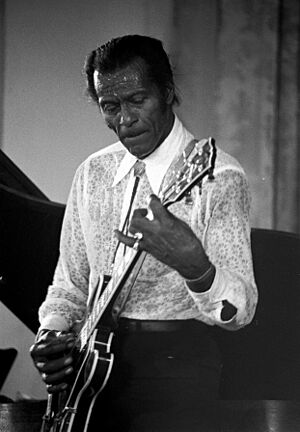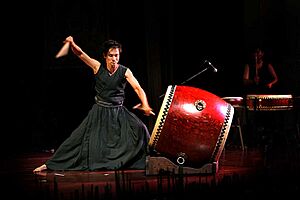Beat (music) facts for kids
A beat is like the steady pulse or heartbeat of a song. It's the basic unit that helps us measure how fast or slow music is, which is called its tempo. Beats are what make music feel rhythmic and help us tap our feet or dance along.
Beats can be strong or weak. Strong beats are often called 'stressed' beats, and weak ones are 'unstressed'. When beats are put together in a certain order, they create time signatures and tempos.
Contents
Understanding Beats in Music
When beats are put together, they form measures, also known as bars. Each beat can also be divided into smaller parts. How these beats are combined and divided helps us understand the meter of the music.
- If two beats are combined, it's called duple meter.
- If three beats are combined, it's called triple meter.
Beats can also be split into two or three smaller parts:
- When a beat is split into two parts, it's called simple meter. Examples include 2/4, 4/4, or 2/2 time.
- When a beat is split into three parts, it's called compound meter. Examples include 6/8 or 9/8 time.
Sometimes, a beat is divided into an unusual number of parts, like five equal parts. These are called tuplets and are considered irregular divisions.
Downbeats and Upbeats

The downbeat is the very first beat of a measure in music. Think of it as beat number 1. The upbeat is the last beat of the measure just before the downbeat. It leads into the next measure. These terms come from how a conductor moves their hand: down for the downbeat, and up for the upbeat.
Sometimes, a short musical idea or group of notes happens before the first full measure of a song. This is also called an upbeat figure, a "pickup," or an "anacrusis." The word "anacrusis" comes from Greek and means "up towards a strike." It's like a little musical run-up before the main part begins.
On-Beat and Off-Beat Rhythms
In music, especially in common 4/4 time (counted as "1 2 3 4"), some beats feel stronger than others.
- The first beat (the downbeat) is usually the strongest.
- The third beat is the next strongest.
These strong beats are called "on-beats."
The second and fourth beats are weaker. These are called "off-beats." If you divide these beats even further, like into eighth notes, the notes that fall between the main pulse beats are even weaker. If a rhythm uses these weaker, in-between notes a lot, it can sound "off-beat."
Let's imagine a simple rhythm:
- 1 2 3 4 1 2 3 4 — The strong beats are on 1.
- 1 2 3 4 1 2 3 4 — Here, 1 and 3 are stressed (on-beats).
But sometimes, musicians intentionally stress the weaker beats. This is called syncopation:
- 1 2 3 4 1 2 3 4 — Here, the stress is on the unexpected off-beats.
"Off-beat" music often emphasizes the weak, even beats of a measure, instead of the usual strong beats. This technique is very important in African polyrhythm and has influenced a lot of Western popular music. In some cases, the downbeat might even be silent or connected from the previous measure, making the off-beat stand out even more. Genres like rock and roll and Ska music often use and emphasize the off-beat as a key part of their sound.
What is a Backbeat?

A backbeat is a type of syncopation where the "off-beats" are strongly accented. In a simple 4/4 rhythm, this means beats 2 and 4 are emphasized.
The backbeat was a big reason why early R&B (Rhythm and Blues) music was so popular and danceable. One of the first songs to really feature a strong backbeat was "Good Rockin' Tonight" by Wynonie Harris in 1948. Drummers like Earl Palmer also helped make the backbeat famous in songs like "The Fat Man" by Fats Domino in 1949. However, hand-clapping and tambourines in urban contemporary gospel music were using backbeats even earlier. For example, "Roll 'Em Pete" by Pete Johnson and Big Joe Turner from 1938 has a hand-clapping backbeat.
The backbeat also became important in country music. In the 1930s, slap bass players used backbeats. Later, Hank Williams's music in the late 1940s and early 1950s brought a strong backbeat to the honky tonk style of country music. The Delmore Brothers also used a hard-driving backbeat in their boogie tunes, like "Freight Train Boogie" in 1946. Fred Maddox's unique slapping bass style, which he used as early as 1937, helped create the rhythm for rockabilly, an early form of rock and roll.
Today, the snare drum is usually the instrument that plays the backbeat in popular music. Early funk music sometimes even delayed one of the backbeats slightly to give the overall rhythm a special "kick."
Some songs, like The Beatles' "Please Please Me" and "I Want to Hold Your Hand", use a double backbeat. This means one of the off-beats is played as two eighth notes instead of one quarter note, making it sound even more energetic.
Hyperbeats in Music
A hyperbeat is like a beat, but on a bigger scale. It's one unit of hypermeter. Think of it this way: just as individual notes make up beats, and beats make up measures, measures can also act like "beats" themselves in a larger pattern. So, a hyperbeat is usually a whole measure.
Other Beat-Related Ideas
- Tatum: This refers to the smallest regular division of a beat where most notes in a piece of music start.
- Afterbeat: This is a percussion style where strong accents are placed on the second, third, and fourth beats of a measure, right after the main downbeat.
- One Drop: In Reggae music, this term describes a rhythm where the first beat of the measure is completely silent or not emphasized at all.
- James Brown's famous funk music style emphasized the downbeat, meaning he put a lot of weight "on the one" (the first beat of every measure). This was different from the common backbeat that many R&B musicians used, which focused on the second beat.
See also
 In Spanish: Pulso (música) para niños
In Spanish: Pulso (música) para niños




